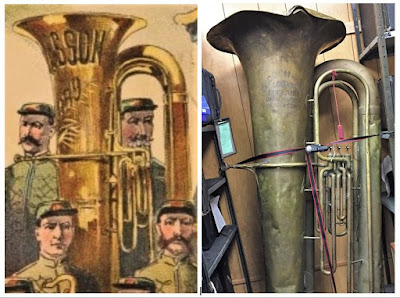Steve Dillon, of Dillon Music, and I have been trying to uncover the history behind the so-called "Harvard tuba," as his shop is in the process of restoring the vintage beast that has lived in the Harvard Band room since 1948. We've still got some gaps to fill in the story, but it's coming along, so stay tuned!
This morning I had the opportunity to see this monster up-close and personal, and I have to say - no photo does it justice. The horn is truly stunning to see in real life! But here are a few shots of my encounter with this rather hefty piece of history that dates to at least 1892, and perhaps even 1889:
That's Steve on the left, and me on the right, and I'm 5 feet 8 inches in height. The tuba is well over seven feet tall! Concerning when this horn was built, check out this side-by-side comparison:
On the right is the tuba today, while on the left is what is almost certainly this exact horn, seen in a lithograph featuring Gilmore's Band of One Hundred in either 1892, or more likely 1891. But on the bell you can see a portion of the giant letters spelling "BESSON," and below that what appears to be the numbers 889 ascending from left to right. It probably reads "1889," which may very well be the year the horn was built.
The engravings on the bell are different today, but we're wondering if the lithographer added those important bits of information so that they could be seen in the poster. Or it could be that the engravings seen today (photo below) were added at a later date.
We thoroughly examined the bell, just in case there was a trace of "BESSON" and "1889" behind what is there today, but found nothing. But there was a small stamp on the back of the second valve:
Blowing that up, here's what we found:
It reads "F. Besson Bte S.G.D.G," which likely means the horn, or at least the valve section, was built in France by F. Besson. The "Bte S.G.D.G" is apparently an abbreviation for the French phrase, "Brevete sans garantie du gouvernement," meaning something like, "Patented without guarantee of the government." Not sure what to make of that yet, but such a stamp is found on many old Besson instruments.
Of course, as noted above, the bell says, "Besson & Co. London England Carl Fischer U. S. Agent New York," so we'll have to reconcile these differences. Was the horn built in France or England? Or, again, was that bell engraving added later to this French-built horn (Besson did have a London factory as well, and Carl Fischer did import Besson instruments).
So, again, stay tuned as we piece together the clues and tell the story of this amazing, oversized tuba! And I'll circle back with Steve in a couple of months when they are done restoring the horn. Until then, here's where it sits, waiting for its makeover:
For an earlier post on this monster, click here.






Nice
ReplyDeleteAstounding!! I had no idea this existed.. Thanks to my tuba playing friend out here on the far left coast, Ed Nystrom
ReplyDeleteYou're right, Dave; "breveté sans garantie du gouvernement" was the statutory language for a patent claimant (from 1844 to the 1960s). You could claim a French patent by right, without having to submit it to a patent office (as in the USA) for testing and examination. It was a sort of consumer warning that the government wouldn't necessarily enforce a claim of infraction.
ReplyDelete